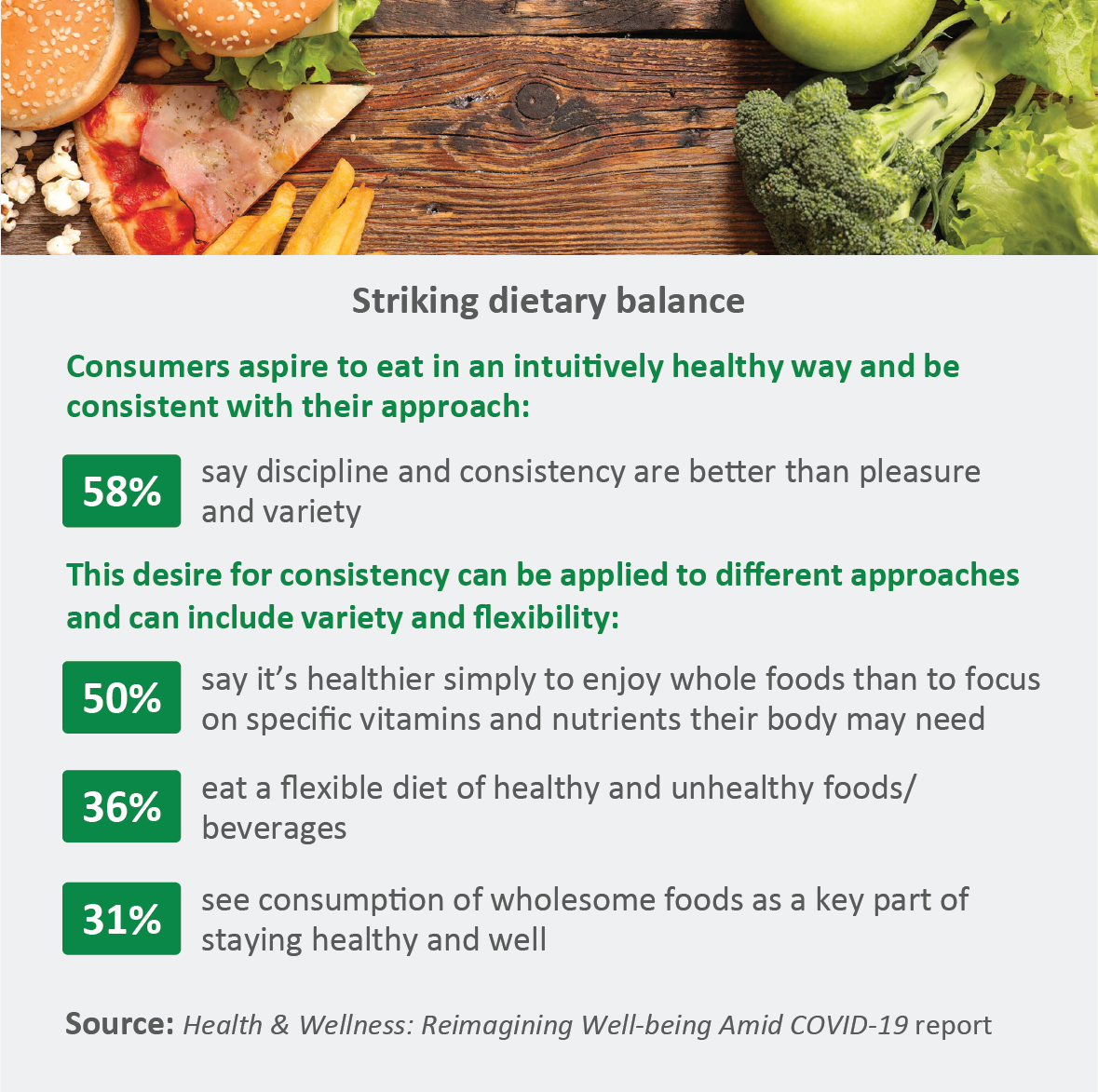As a result of more focused effort, 4 out of 10 consumers consider their diets healthier than before the pandemic. Consumers employ a number of different eating approaches as unique as consumers themselves, including eating in “an intuitively healthy way” and seeking dietary balance.
Emblematic of the pandemic, our 2021 Health & Wellness: Reimagining Well-being Amid COVID-19 report found that as consumers experienced weight gain (and a corresponding renewed interest in trying to manage weight) they also voiced a renewed interest in food itself as a key tool for weight management as well as the overall foundational role of dietary choices in health and wellness.
It makes sense: After months (now verging on years) of pandemic living, consumers began to rethink their approach to food by trying to have a better understanding of what goes into their food, adjusting their caloric intake according to changing lifestyles, and being more thoughtful about when to visit their pantry. Of interest, when asked how their diet differs today from before the pandemic, 41% of consumers said “better or somewhat better.”
And yet, pandemic-influenced shifts in consumers’ lives have altered needs and notions around diet and nutrition with consequent changes in habits and the context in which foods and beverages are consumed. Two examples include:
Shifting habits—preparing food at home: While consumers are returning to restaurants, the rise in cooking at home has given some consumers a new degree of control and choice when it comes to “eating clean.” Specifically, home-cooked meals tend to have a health halo, but some consumers note portion control as a challenge that can undermine health benefits. The pandemic certainly activated greater interests in cooking: Health and Wellness 2021 found that 37% of consumers said they started or increased cooking in response to the COVID-19 pandemic.
Shifting contexts—home pantries always at hand: While some are returning to the office, consumers working at home are there most of the day with pandemic-stocked pantries. In addition, the commutes and scheduled breaks that once marked the day have gone by the wayside for some. With fewer barriers to eating at any time, consumers feel a need to be more mindful eaters. Echoing issues with changing eating contexts, among consumers who thought their health worsened during 2020, Health and Wellness 2021 notes that 23% said constant access to their pantry made it harder to stay healthy.
Shifting habits and contexts have resulted in consumers saying they aspire to eat in an intuitively healthy way and with consistency in their approach. While a majority of consumers (58%) claim to favor a disciplined and consistent diet (over pleasure and variety), there may be an aspirational aspect to this approach. What these consumers want to be consistent about may also vary—as one may strike a balance of healthful and indulgent foods and be disciplined about maintaining the optimal ratio.
Frequent home cooking has brought many consumers closer to the individual ingredients in their meals, seeking out less processed options and key nutrients from food: fiber, protein, calcium, nuts and seeds, and whole grains. Health and Wellness 2021 found that renewed focus on vitamin D’s immunity benefits and potential ability to protect against severe COVID-19 symptoms have seen this nutrient top consumer priorities for dietary inclusion.
Sugar and sodium, on the other hand, remain at the top of consumers’ blacklist. However, consumers are finding ways to incorporate sweetness into their eating and drinking routines by managing occasions and reaching for more healthful sweetener choices.
A focus on gut health: Our recent trends report “Ideas in Food” analyzes how as the digestive wellness trend deepens, consumer awareness of the microbiome as the root of all wellness and its connection to our mental well-being and immunity is expected to mainstream more broadly.
Increasing numbers of consumers are seeking more plant-rich (not meat-free) diets. But while consumers’ search for plant-based labels has gone mainstream in recent years, a growing concern about ingredients and processing levels of these products—especially plant-based meat alternatives—is now sending more discerning consumers in search of simpler, purer replacements.
|
What’s Next? With the COVID-19 pandemic precipitating shifts in consumer needs, tactics, and contexts around food and cooking, approaches to nutrition and eating are evolving. We are currently exploring these topics in our Modern Approaches to Eating 2022 syndicated study which explores in depth the spectrum of eating approaches that consumers pursue today, along with the attitudes, needs and goals that motivate them and the considerations and challenges they encounter along the way. You can download a free overview and order form for Modern Approaches to Eating here Please Note: Early bird price discount expires May 15th. |


